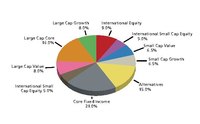
Photo from wikipedia
Abstract The Margrabe Best-of-two (MBo2) strategy is a rule-based dynamic investment solution for the two-asset allocation problem. Its typical implementation involves yearly rebalancing the portfolio weights to 50–50 between a… Click to show full abstract
Abstract The Margrabe Best-of-two (MBo2) strategy is a rule-based dynamic investment solution for the two-asset allocation problem. Its typical implementation involves yearly rebalancing the portfolio weights to 50–50 between a low-risk and high-risk asset. It uses intra-year weight adjustments to chase the momentum of the best performing asset by replicating the Margrabe formula for the value of a European option to exchange an asset for another asset at year-end. In practice, this means that the Margrabe portfolio allocation benefits from the upside potential of the high-risk asset and the downside protection from the low-risk asset. The MBo2 allocation depends on the assets' prices, their return volatilities, and correlation, as well as the remaining time until year-end. In this paper, we derive analytical formulae and use simulations to provide insights into the sensitivity of the strategy's weights and performance to these input parameters. We also report the results of an extensive out-of-sample evaluation for the MBo2 strategy applied to the bond–equity, real estate–equity, and world equity–emerging market equity portfolio allocation problems.
Journal Title: International Review of Financial Analysis
Year Published: 2019
Link to full text (if available)
Share on Social Media: Sign Up to like & get
recommendations!